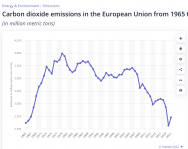
EU owe $11.36 TRILLION to Cop27 Loss & Damage Fund – new report
Calculations by Off-Grid.net show the EU total liability under the new Cop27 agreement announced in Egypt today, is $11.36 trillion.
Assets of the Loss & Damage fund are currently standing at zero, but countries will be under pressure to contribute quickly. The speed at which this should be paid is open to debate and clearly depends on what each country can afford, but the total EU bill is relatively easy to calculate.
About $2 trillion of the $11.4 trillion is directly attributable to the EU itself, rather than being owed by its 27 member countries, because the basic tenets that the European Commission has promoted since it was first founded in 1952, encouraged, indeed coerced, its member states to burn fossil fuels.
Loss and damage refers to the most severe impacts of extreme weather on the physical and social infrastructure of poor countries, and the financial assistance needed to rescue and rebuild them.
It was the most contentious issue at the COP27 conference, and has been a long-running demand by developing countries since 1992. For nearly two weeks, the EU and the US refused demands from poor countries for a new fund to address loss and damage, arguing that existing funds should be redirected for the purpose. Early on Friday morning, the EU made a U-turn, to agree to a fund on condition that big economies and big emitters still classed as developing countries under the UNFCCC rules, which date back to 1992, should be included as potential donors, and excluded as recipients.
From its very first moment, the EU was all about burning energy – it had been brought into being to foster the burning of coal, the production of power, and the regulation of giant corporate interests.
It launched in 1952, called the European Coal and Steel Community (ECSC). In 2002 Romano Prodi said: “The ECSC was a courageous and hugely significant leap forward for Europe. It was Europe’s first step in pooling a part of each country’s sovereignty for the greater good of all who took part. It was the ECSC which first established shared, supranational institutions for Europe – the basis of the EU as we know it today and a milestone in political history. History will record the founding of the ECSC as a defining moment.”
The stated aim of the ECSC was “economic expansion, employment and better living standards.” They achieved all three – but at what cost?
The Coal and Steel Group had a High Authority to:
• supervise the market;
• monitor compliance with competition rules; and
• ensure price transparency
The aim of the 1952 treaty, as stated in its Article 2, was to contribute, through the common market for coal and steel, to economic expansion, employment and better living standards. Thus, the institutions had to ensure an orderly supply of coal and steel to the common market by ensuring equal …